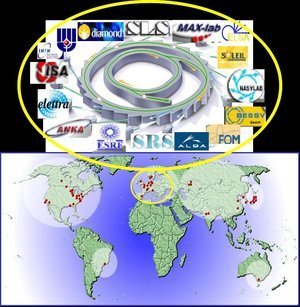Symposium INew Opportunities and Challenges in Material Research using Synchrotron and Free Electron Laser Sources |
|
Symposium INew Opportunities and Challenges in Material Research using Synchrotron and Free Electron Laser Sources |
|
New opportunities and challenges in material research using synchrotron and free electron laser sources is a topical subject of debate more than ever, since the first decade of this century is marked by an exponential increase of the number of new ultra-bright light facilities that are already operational or are in advanced commissioning or construction stages. The scope of this symposium is to feature the cross-disciplinary efforts and achievements in material science and technology at the Synchrotron and Free Electron Laser (FEL) laboratories, highlighting the latest progress and the emerging new fields.
The Organisers invite participants from academic, research and industrial institutions to present their results, interact and share their knowledge and discuss future research directions and development of appropriate research tools. Representatives from industry, graduate students and post-docs who wish to learn more about the new research opportunities at various Synchrotron and FEL facilities are especially welcome.

In the last decade Synchrotron and Free Electron Laser (FEL) facilities have been at the forefront in interdisciplinary science and research, playing a pivotal role in characterization of advanced materials at various dimensional and temporal scales. The growing interest and high technological relevance of the synchrotron-based research have justified multi-billion investments for construction of new facilities both in Europe and worldwide.
The symposium “ New Opportunities and Challenges in Material Research using Synchrotron and Free Electron Laser Sources” takes place in a year when several new facilities are opening doors to the users. It aims at highlighting the recent advances in material research with synchrotrons and the scientific and technological breakthroughs expected from the emerging FELs. The emphasis will be on identifying the opportunities and challenges in characterizing material properties at atomic to micron scales and relevant dynamic processes occurring at fs to sec time scales.
The main topical areas of the first three days will be nano-structured, electronic and magnetic materials, materials under extreme conditions, disordered materials, thin films and interfaces and innovative instrumentation. The last day sessions will be fully dedicated on ultra-fast x-ray science with new sources, and discussions about the strategic role of the present and future synchrotron and FEL facilities, addressing major multidisciplinary and development issues, such as research tools, fast and efficient x-ray and electron detectors, etc. The topics, selected by the program committee, will be covered by keynote and invited talks, complemented by oral/poster presentations. The last session includes invited presentations on the status of the FEL projects in Europe.
Confirmed Invited and Keynote Speakers
Confirmed Speakers presenting the FEL projects in Europe
ALTARELLI Massimo, DESY, D
EBERHARDT Wolfgang, BESSY, D
FLAVELL Wendy, SRS-Daresbury, UK
MÅRTENSSON Nils, MAX-Lab, S
PARMIGIANI Fulvio, ELETTRA, I
WRULICH Albin, SLS-PSI, CH
Symposium Chair:
Sincrotrone Trieste, 34012 Trieste, Italy
e-mail: [email protected]
Contact Person: Mrs. Ilde Weffort: [email protected]
Symposium Co-chair:
Prof. Krystyna Lawniczak-Jablonska
Institute of Physics, Polish Academy of Sciences
Al. Lotnikow 32/46, 02-668 Warsaw, Poland
e-mail: [email protected]
Symposium Co-chair:
Dr. Rachid Belkhou,
Synchrotron SOLEIL,
BP 4891192 GIF-sur-YVETTE CEDEX, France
e-mail: [email protected]
Program Committee:
1. Helmut Dosch, Max-Planck-Institute of Metal Research, Stuttgard, Germany.
2. Hermann Dürr, BESSY, Berlin, Germany.
3. Salvador Ferrer, ALBA, Barcelona, Spain.
4. Wendy Flavell, University of Manchester and SRS-Daresbury Laboratory, UK.
5. Gerhard Materlik, DIAMOND, Oxfordshire, UK
6. Nils Mårtensson, MAX-Lab, Lund University, Lund, Sweden.
7. Fulvio Parmigiani, University of Trieste and ELETTRA, Trieste, Italy.
8. Christoph Quitmann, SLS-Paul Scherrer Institut, Villigen, Switzerland.
9. Michele Sauvage, SOLEIL, Paris, France.
10. Francesco Sette, ESRF, Grenoble, France.
11. Jochen Schneider, DESY, Hamburg, Germany